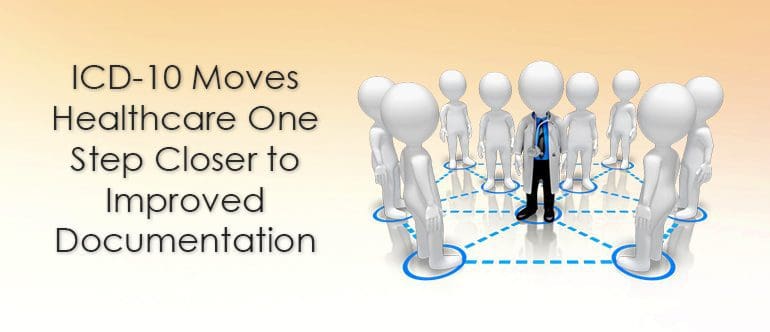Call us toll-free: 800-878-7828 — Monday - Friday — 8AM - 5PM EST

Article by Karen Diop, RN, CDIP. This article was originally published on the Journal of AHIMA website in the “Coding Notes” section in November 2015 and is republished here with permission.
Change has become a constant in healthcare. With the introduction of electronic health record (EHR) systems, core measures, the “meaningful use” EHR Incentive Program, value-based purchasing, and the ICD-10-CM/PCS code sets, the healthcare industry has been bombarded by wave after wave in a sea of changes over recent years. Some physicians have even retired early rather than deal with all of this change, while others have dug in their heels and fought against the change every step of the way.
Coding professionals and clinical documentation improvement (CDI) specialists have been working with physicians of all types and temperaments, trying to improve their documentation in ICD-9. These efforts have become even more critical with the implementation of ICD-10-CM/PCS.
The very changes that have come with the implementation of ICD-10-CM/PCS, however, could be exactly the opportunity that CDI professionals need. This new environment can create a catalyst for physician buy-in for clinical documentation improvement programs. There is more at stake than ever for physicians now, with the transition to payments based on value—reflected in acuity vs. cost—and impending penalties related to value-based purchasing that can result in decreased Medicare reimbursement. Many physicians remain unaware of how their documentation impacts coding and reimbursement, reporting, and even their reputation as a provider.
The Centers for Medicare and Medicaid Services (CMS) has been collecting data for hospitals and physicians for several years, establishing national averages for comparison. New and impending penalties, calculated based on this data collection that can range from two percent to 10 percent of Medicare reimbursements, will now affect hospitals as well as physicians. In the past, clinical documentation improvement efforts were often associated with hospital reimbursement and rarely were viewed as having any bearing upon physicians—but this is no longer the case in the modern healthcare landscape.
A large portion of the data that have been and continue to be collected as part of the new data-driven realities of healthcare come from past ICD-9 and current ICD-10 codes, in addition to CPT and HCPCS codes. Almost all reported data are derived from coded data that are based upon clinical documentation. CMS will also be looking at Medicare spending per beneficiary and comparing costs to DRG assignment to determine value. Therefore, what is accurately and adequately documented, and then subsequently coded, is critical to both hospitals and physicians.
The transition to ICD-10-CM/PCS presents a great opportunity to work more closely with physicians and support them while working through all this change. The current environment of change in healthcare presents an opportunity to collaborate with physicians with an even greater purpose at hand, instilling the values and importance of clinical documentation improvement efforts and relating that to accurately reflecting severity of illness, risk of mortality, and length of stay—and what that will mean for providers.
Health information management (HIM) professionals have the chance to establish themselves as the “go-to” expert resource on ICD-10 and related matters for physicians. Collaboration is the key to success. HIM professionals should take this time to continue to educate physicians as to the extent of associated benefits with ICD-10 and clinical documentation improvement, driving home the benefits that are specific to providers as well as potential detriments if proper documentation is not taken seriously.
Not only will improved documentation lead to more accurate reimbursement with less potential of error-related penalties for providers, but this transition brings the ability to report severity of illness and risk of mortality more accurately. The ability to collect better data for research arrives with ICD-10 as well. Accurate documentation leads to accurate coding. Accurate codes reflect the care provided and associate that with costs.
Clinical documentation improvement programs are increasing in popularity and importance as the changes brought about by the Affordable Care Act affect not only the hospital’s viability but that of physicians as well. Now, everyone has something at stake. Having the right documentation allows providers to validate acuity, justify inpatient admissions, meet core measures, deal with complications and readmissions, and ensure that all present on admission conditions are accurately noted. HIM professionals need to be the ones to tie it all together.
ICD-10 and CDI go hand-in-hand, as the increased specificity and detail that will be present in improved documentation supports the more granular nature of the new code set. Adjusting to these new changes in the healthcare environment won’t be easy, but a positive attitude and education as to what matters goes a long way to getting people on board—along with a reminder that all of the hard work will be worth it. After all, HIM professionals made it through the transition periods with ICD-9 and MS-DRGs, right?
Many physicians thought these days would never come and hoped that further delays might even lead Congress to banish ICD-10 altogether. With the implementation of ICD-10-CM/PCS, HIM professionals must embrace their role as educators and supporters; physicians will need HIM’s help more than ever. HIM professionals need to portray themselves as the expert resources that they are, supporting the physicians and assisting them with adjusting to all these changes.
HIM and CDI professionals are the cornerstone of this new healthcare landscape. Without the correct documentation, hospitals and physicians may fail. HIM and CDI professionals can’t let that happen. There is too much at stake.
